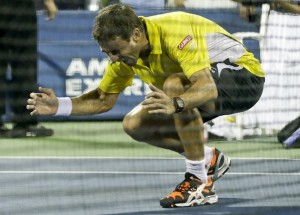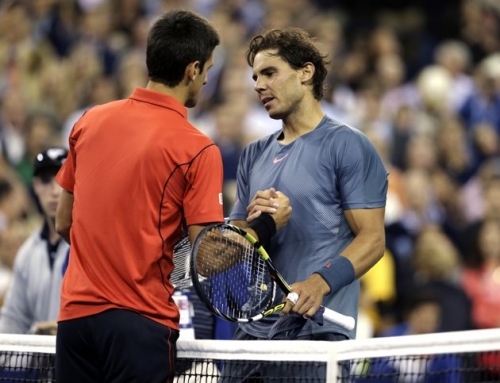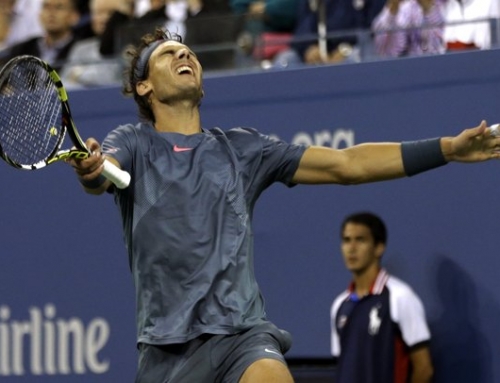 One stat that came up frequently prior to this match was the 10-0 record Federer had over Tommy Robredo. However, eight of those victories came in 2007 earlier. Since then, the two have only met twice, once in 2009 and once in 2011. Most of that has to do with issues that have afflicted many of Roger’s contemporaries: injuries.
One stat that came up frequently prior to this match was the 10-0 record Federer had over Tommy Robredo. However, eight of those victories came in 2007 earlier. Since then, the two have only met twice, once in 2009 and once in 2011. Most of that has to do with issues that have afflicted many of Roger’s contemporaries: injuries.
Think about Federer’s contemporaries: Lleyton Hewitt, Tommy Haas, Marat Safin, Juan Carlos Ferrero. Some of them have already retired. Add Tommy Robredo to that group. Robredo hasn’t been relevant in half a decade, but more recently, due to injuries, Robredo has had to take time off, watch his rankings slip, and play Challengers.
This year, Robredo has primarily played in the main tour, but his success really picked up on clay. Semis at Buenos Aires. Winner at Casablanca. Quarters at Roland Garros. Winner at Umag. It’s been such a good year that he’s seeded at the US Open.
But seriously, few people expected Robredo to bother Federer given how he struggled somewhat against Daniel Evans. Federer was going to be a different class of opponent.
Federer, of course, has had his problems. Early loss at Wimbledon. Upset loss at Hamburg. Early loss at Gstaad. He skipped Montreal, then faced Nadal in the quarters at Cincy where he lost a close match. Many felt Federer wasn’t 100%, but that he looked better, and perhaps things would turn up.
The first three rounds went pretty smoothly for Federer and culminated in a third round pummeling of Adrian Mannarino who couldn’t handle the pace.
Originally, Federer was scheduled as the third match on Arthur Ashe, but rain fell shortly after noon and delayed play for more than four hours. Tournament organizers rearranged the scheduled and put Federer-Robredo on Louis Armstong, the second largest stadium at the Open. Federer hadn’t played off Ashe since 2006.
This match looked bad for Federer from the get-go. Robredo’s has a decently paced serve, hits lots of high, heavy topspin shots, and seemed intent on making Roger play longer points. Conditions, after the rain, were quite humid and heavy. Federer seemed intent on hitting hard, regardless of the results, and this produced a flurry of errors.
Federer had 43 unforced errors, a large number over 3 sets, but not unusual for Federer. Federer has always seemed to prefer making a lot more errors if it means he can stay aggressive.
It was once said that Soderling was a one-trick pony, a hard hitter that didn’t have variety to his game. Federer has some variety, but when his power game is off, Federer doesn’t seem to want to play, say, patient ball. Better to lose quick, then to lose slow, it seems.
But the big telling stat was Federer’s inability to convert break points, something that has primarily plagued him at Wimbledon. Some of that has to do with Federer’s stubborn insistence on returning serve just behind the baseline making his job returning serve that much tougher. Federer hates the idea of standing as far back as Nadal who stands several meters behind the baseline, as if he’s afraid to hit the ball.
But more than that, on break points, Federer would either make errors, slapping the ball in the net or long, or he’d play cautiously and Robredo would get to net or hit a big forehand.
To be fair, a lot of Federer’s problems were Tommy Robredo. Robredo mixed up his return positions, used his heavy topspin, and powered crosscourt forehands that left Roger rushing to his right trying to fetch balls. In other words, Robredo was pushing Federer around when he had the chance.
While some had hoped that Federer would come back like Jimmy Connors did against Aaron Krickstein in 1991, Robredo is too solid a player, too veteran a player, to let his game drop that much. And when Federer failed to convert a 0-40 game that would have given him the lead and perhaps change the momentum, it seemed to spell doom for Federer’s chances ton come back.
This result means Federer has failed to reach a Slam final, and also continues a streak of missing quarterfinals in Slams to two.
Ferrer tops Tipsarevic in rematch of last year’s quarterfinal
What a difference a year makes. Last year, Ferrer was having his best year, winning more tournaments than any player that year. Tipsarevic was trying to maintain his ranking in the top ten, an effort that would eventually qualify him for the year-end championship in London.
Last year, in the quarterfinals, the two played played a gruelling, beat-down match. Of all players on the tour, Tipsarevic comes closet to playing like Ferrer, lacking huge weapons, but good enough to grind. Although the match changed momentum several times, Ferrer ultimately showed that there’s only one Ferrer and that he’s still the one to beat for his style of play.
This year, Janko Tipsarevic saw his ranking plummet as he had ten first round losses. He did have success very early on winning in Chennai and having a decent Australian Open. Many speculated that Tipsarevic was injured, but that showing up to tournaments was worth more than taking a break to recover. His rank, which had been top ten, slipped down to 20, enough for him to be seeded, but not playing the level that he played last year.
Meanwhile, Ferrer has been playing well for four years with rare lapses. This year, however, he’s had lapses. He’s had two losses to Dimitry Tursunov (who admittedly is having a good comeback year), losses to Bogmolov and Malisse in opening rounds. Of course, outside those small blips in tournaments, Ferrer has done his awesome self making it deep in most tournaments.
Tipsarevic was likely desperate to salvage his year and show that he can be top dog, but, as usual, Ferrer was having none of that. Despite numerous breaks to lead, Tipsarevic was unable to secure a second set, and ultimately lost in the fourth set.
Raonic facing Gasquet





![[US Open Men’s Final] Can Djokovic beat Nadal in the finals?](https://www.essentialtennis.com/wp-content/uploads/2013/09/20130909djokovic-500x383.jpg)
![[US Open, Semis] Djokovic and Nadal to play US Open final once again](https://www.essentialtennis.com/wp-content/uploads/2013/09/20130907nadal-500x383.jpg)
![[US Open, Day 11, QF] Wawrinka upsets Murray in straight sets to make first Slam semi](https://www.essentialtennis.com/wp-content/uploads/2013/09/20130906wawa-500x383.jpg)